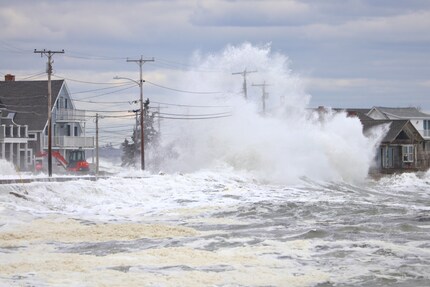
Researchers at the University of Hamburg develop storm surge AI
Storm surges pose an increasing threat to coastal regions. Scientists at the University of Hamburg have now developed an AI that enables more precise forecasts than previous models.
A team of researchers at the University of Hamburg has developed and trained an artificial intelligence (AI) that can accurately predict the frequency and height of storm surges. This technology could significantly improve coastal protection and the planning of dyke constructions, according to a press release.
Under the leadership of Dr Daniel Krieger from the Centre for Earth System Research and Sustainability (CEN) at Universität Hamburg, the AI was trained using extensive weather data, traditional climate models and historical water level measurements. In particular, the researchers analysed the locations of Cuxhaven (Germany), Esbjerg (Denmark) and Delfzijl (Netherlands).
Training with historical data: how the model works
Hourly water levels that have been measured for decades were used for the analysis. For example, there are around 700,000 measured values for Cuxhaven since 1940.
The results of the study were published in the scientific journal Geophysical Research Letters. They show that AI can provide reliable predictions for the next ten years. In the last ten years, an average of 11.6 storm surges per year were recorded in Cuxhaven. The model predicted 12.8 storm surges per year for the same period in the future, with a tolerance range of 1.6 storm surges.

Source: Arthur Villator / Shutterstock
It is important to mention that, according to the study, the forecasts for individual years are not very reliable. Long-term decade forecasts, on the other hand, are much more reliable and provide valuable information for coastal protection and long-term planning. The forecasts for the height of storm surges are also remarkable. While the highest annual storm surge in the last ten years averaged 2.5 metres, the model indicates an average height of three metres for the next five years.
From theory to practice: relevance for coastal protection
These precise predictions are of great importance for coastal protection, planned dyke construction and the safe infrastructure of harbours. Until now, climate models have only been able to calculate whether more storms will occur in the North Sea in the future, but not how they will affect specific coastal locations.
The AI predictions are expected to provide interesting results, especially for the 2030s. An internal climate fluctuation that is currently dampening the effects of sea level rise could have the opposite effect in a few years and lead to higher storm surges.
With this new method, the researchers hope to provide targeted and rapid forecasts for various coastal locations. It takes just under a second to calculate such a forecast, which is several hundred times faster than traditional climate models.
Challenges for the AI model
The study points out that the model can only be reliably trained for coastal locations with comprehensive historical measurement data. In addition, complex interactions, particularly between tides and storm surges, are not fully captured. External influences, such as strong currents from the Atlantic, can also affect the accuracy of the predictions and pose a challenge for the modelling.
My interests are varied, I just like to enjoy life. Always on the lookout for news about darts, gaming, films and series.
From the latest iPhone to the return of 80s fashion. The editorial team will help you make sense of it all.
Show all